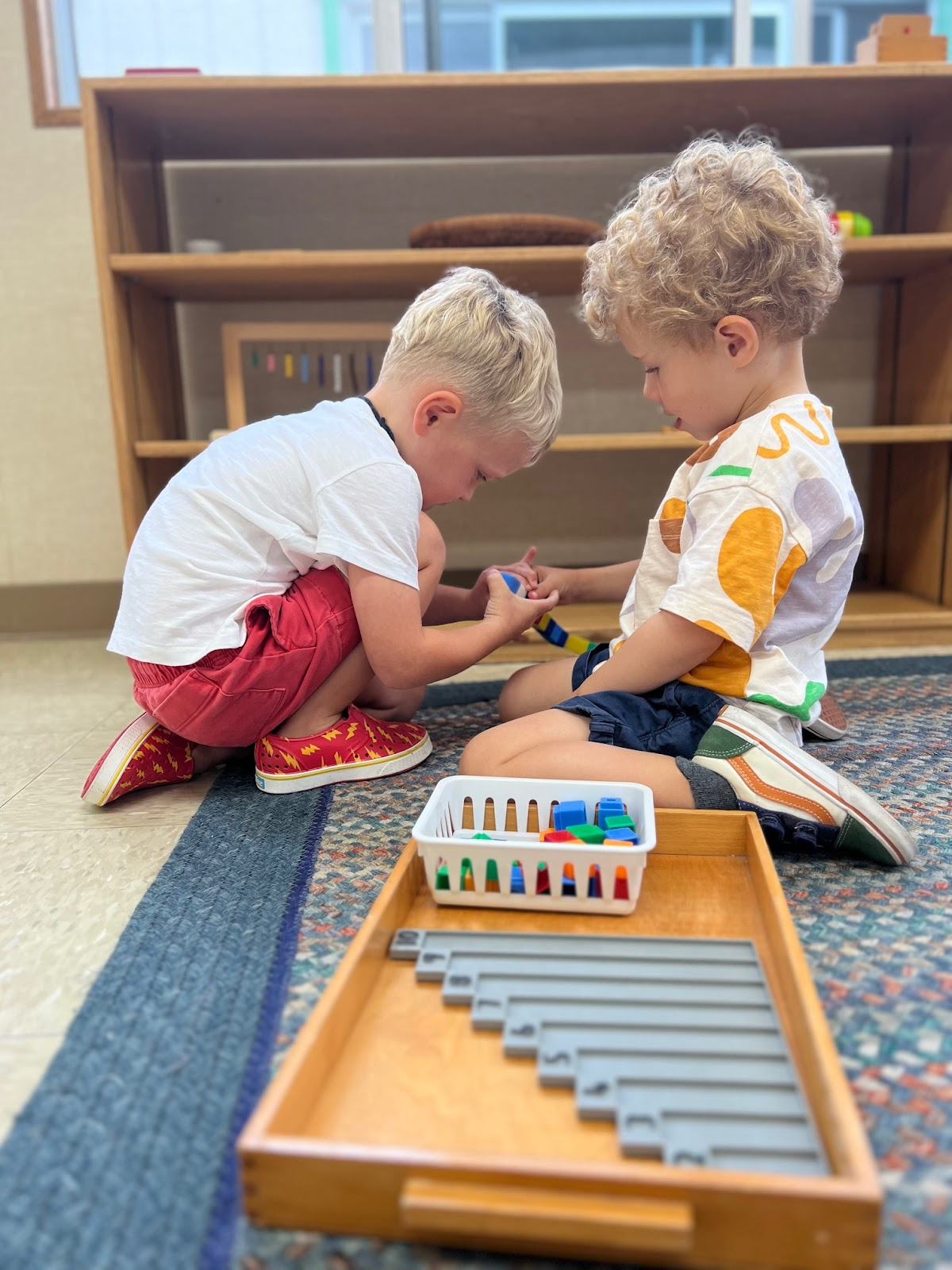Blog
Blog
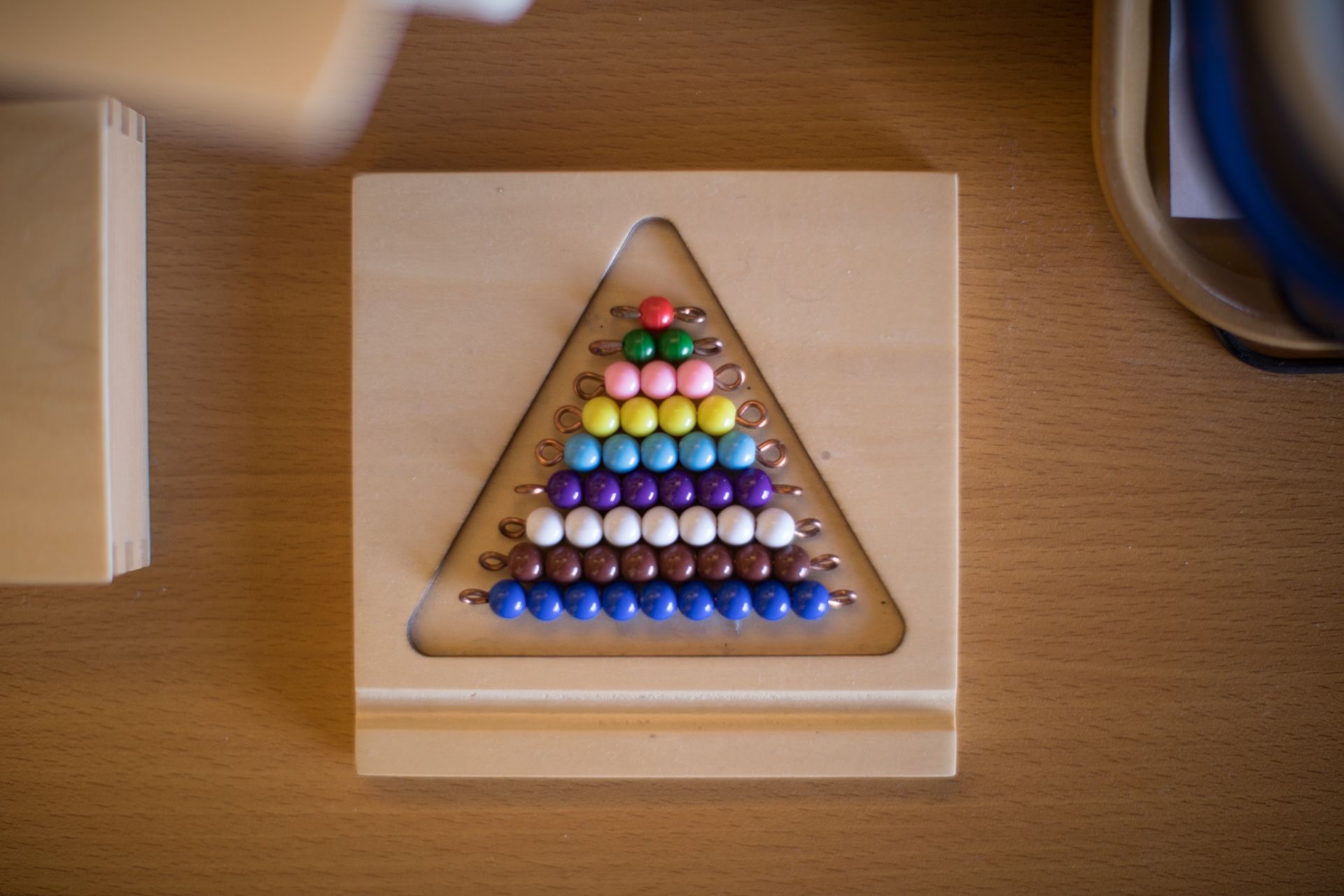
By Lisa Lavora - De Beule
•
05 Apr, 2024
When you look inside a Montessori classroom, you’ll notice the general attractiveness and warm quality of the room. As you peruse the environment, you may also notice the array of colorful materials on the shelves and how they stand out in contrast to some of the neutral feel of the rest of the room. These colorful learning materials are designed for beauty so that our young children will be drawn to them. However, this isn’t the only reason Montessori materials have distinct colors. The color-coding also helps with organization and structure in the learning environment, and perhaps even more importantly, plays an important role in facilitating children’s cognitive development and learning. Creating External and Internal Order In our toddler and primary classrooms, practical life—activities like scrubbing a table, cleaning a window, watering a plant, or creating a flower arrangement—are set up so that all of the objects for a particular activity are arranged by color. This way young children can rely on color cues to know what objects go together and to independently access supplies, like getting a dry apron. Sensorial materials often use color to help isolate a quality and help children develop their perception. For example, when discriminating dimensions with the pink tower, all of the cubes are the same shade of pink. Color-coding is also used to help children pair two identical sets of materials, like when matching sounds with the sound cylinders. These forms of color-coding help children with both the order in their surroundings and also in constructing an internal sense of order. Integrated Throughout The color-coding gets even more interesting as children move into more academic subjects, like language, mathematics, and even geography. When our primary children begin to use puzzle maps, they start with the continent map, a two-dimensional representation of Earth, and the continent globe, which shows the planet as a sphere. The puzzle map and the globe show the continents, and each is painted a distant color: North America is orange, South America is pink, Europe is red, Asia is yellow, Africa is green, Oceania is brown, and Antarctica is white. As children begin to learn the physical representation of each continent, they also associate a color with that continent. All other learning materials that involve the continents–such as picture packets, information cards, or booklets–maintain this color scheme. In the math materials, children learn to associate a quantity with both the number of beads represented and the color of those beads. The beads are the same size but change only by the number on the bead bar and the color. So a ten bar is always constructed of ten gold beads, a nine bar with nine dark blue beads, eight with brown, seven with white, six with light purple, five with light blue, four with yellow, three with pink, two with green, and one with red. This color scheme is consistent throughout all the math materials that use the bead bars, from the simplest lessons in the primary to advanced cubing and cube roots in the elementary and beyond. Similarly, there is clear and consistent color coding in other materials and concepts, such as with the hierarchy of numbers to designate place value or the role of different parts of speech with the grammar materials. Strengthening Neural Pathways While this color coding does continue to help with organization and structure, now the color also helps children with their cognition and memory. Color has long been used as an effective tool in marketing, through brand recognition, consumer attitude, and purchasing decisions. How the brain processes color impacts our children’s attention, comprehension, and retention. Dr. Maria Montessori may not have had all the current-day studies at her disposal, but she did recognize the power of color in the learning process. We now know that color connects neural pathways and integrates different forms of intelligence, which allows learners to construct more consolidated meaning and make deeper cognitive connections with content. When learning the quantity of six, children count the six light purple beads on the bar to determine the quantity of six. At the same time, neurologically they are creating pathways in their brain for quick and easy recall when they see the light purple bead bar so they can immediately think “six” in the future rather than having to count the beads. Later, when children start to use the bead bars for advanced work with compound multiplication, the distributive law, squaring, cubing, and so much more, the neural connections they have are strengthened by both a clear and concrete understanding of the quantity and the associated color. Leading to Abstraction The color-coding in math, language, and other subjects, also helps children move from the very concrete to more abstraction and symbolic representation. Because they learn to associate nouns with black equilateral triangles and verbs with red circles, as children analyze sentence structure they can begin to parse out the subject and predicate by using those two color-coded shapes and eventually even just the color. With the understanding that our decimal system place values have associated colors–units are in green, tens are blue, hundreds are red–children can better conceptualize the pattern in the numerical hierarchies because unit thousands are also green, ten thousands are blue, hundred thousands are red, and then unit millions are green, and so on. This color-coding also helps when we move into operations with larger numbers and quantities. When children move from very tangible representations of a bar of ten beads to represent ten and a square of one hundred beads to represent a hundred, they use small color-coded tiles with just the color and number. Thus children can manipulate a blue tile with 10 printed on it and a red tile with 100 printed on it, and (thanks to the neural pathways established) fully understand what those tiles represent as they add, subtract, multiply, and divide. A Powerful Aid The power of color is fully integrated throughout Montessori classrooms and provides an amazing aid to children’s cognitive development. In addition to helping memory and learning, the color brings beauty and appeal to our learning environments while also supporting children’s independence! We recommend coming to see this for yourself. There are so many examples of how color brings learning to light. Contact our Admissions Director, Tyler ([email protected]), and schedule a tour today!
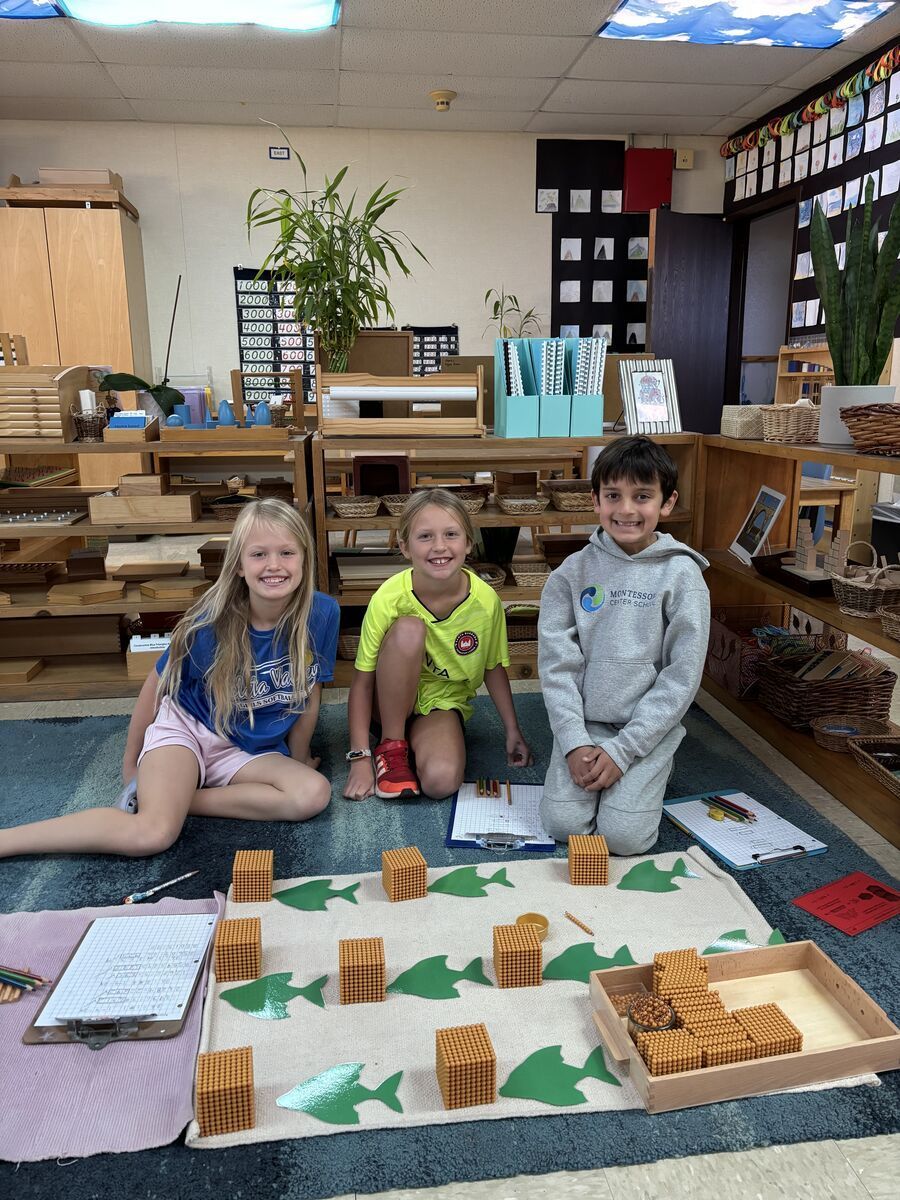
By Lisa Lavora - De Beule
•
04 Mar, 2024
In Montessori, we nurture grace and courtesy in the classroom. But what does grace and courtesy really mean? And what role do they play in supporting the development of social relationships? What is Grace? What is Courtesy? Let’s first isolate each word. Grace can be defined in two parts: 1. simple elegance or refinement of movement, and 2. courteous goodwill. Courtesy is defined simply as: the showing of politeness in one’s attitude and behavior toward others. Stated another way, grace and courtesy comprise how we move through the space around us showing respect for ourselves and others. Grace & Courtesy Lessons In our toddler and primary classrooms, grace and courtesy are considered to be part of practical life learning and we devote time to grace and courtesy lessons. For example, teachers give instruction on how to walk around someone’s work on the rug, how to wait your turn, how to offer help, how to tuck a chair under the table, or how to introduce oneself. These lessons are offered one-on-one or in small groups and we often use role playing as a technique for exploring the skills. In the Older Years As children enter their elementary years, our approach shifts slightly. Elementary-age children are more focused on their social interactions and are learning how to navigate the ups and downs of friendships. As such, much of the grace and courtesy work at this level provides children with tools for communicating directly and respectfully, sharing perspectives thoughtfully. In addition, they are learning how to interact with the broader community as they arrange visits or interviews, conduct themselves according to the norms of different communities, and explore how to be a host or be a guest. The Goal The goal in Montessori education is that these acts of grace and courtesy aren’t rigid expectations, like insisting that children say please and thank you. Rather, they become part of how children want to be and interact. Dr. Montessori is quoted as saying: “…the essential thing is that [the child] should know how to perform these actions of courtesy when his little heart prompts him to do so, as part of a social life which develops naturally from moment to moment.” Like all other exercises in Montessori prepared environments, we offer opportunities to regularly practice and repeat grace and courtesy skills. Because these experiences are part of the normal functioning of the day, they provide a respectful way for young people to learn expectations and for adults to provide scaffolding and assistance for social skills. The Results In time, as we offer these grace and courtesy opportunities and give children a safe place to practice, our young people eventually perform these skills independently. Curious to learn more about the Montessori approach? Contact us today to schedule a tour.

By Lisa Lavora - De Beule
•
06 Feb, 2024
The '90s was truly a golden era for fashion and style. In the spirit of our upcoming Auction Benefit , we compiled some of the more wearable fashion trends from the ’90s. Men's Trends Minimalist Tailoring: Men wore monochromatic jackets or blazers with pants and a solid or graphic t-shirt underneath. Leather: blazers, jackets, vests, pants, Dr. Martens or other combat boots. Plaid/Flannel: Flannel and/or plaid shirts were associated with the era’s grunge scene. Layer under a blazer, tie around the waist or open with a plain or graphic T-shirt underneath. American Prep: Brands like Nautica, Polo and Tommy Hilfiger were embraced for their bright colors, stripes and country club sporty aesthetic. Track suits : drawing inspiration from 90s hip-hop culture (Beastie Boys, Run DMC, etc.) the options range from the classic Adidas version to dressier options from designer brands. Women's Trends Slip dresses: Slip dresses epitomized the minimalist look during this period. These dresses were also paired with a t-shirt underneath for a more casual look or with a leather jacket or blazer on top. Plaid: From grunge influences to Cher from the movie, Clueless , plaid was popular. Plaid flannels were worn as shirts, but most often tied around the waist as a trendy ’90s look. Animal print: The animal print really was everywhere, from hats to coats and dresses. Monochrome Black + Leather: The monochrome black ensemble, an outfit consisting of black from head to toe is fashionable no matter the decade. Leather was popular during the ‘90s thanks to grunge culture and the hit movie, The Matrix. American Prep: plaid, logo branded tops, stripes and pop colors from J.Crew, Polo, Tommy Hilfiger and Nautica. Footwear: Timberland boots, derby shoes, Air Jordans, Adidas shell tops, strappy sandals, platform sandals, Dr. Martens, combat boots, Converse. Additional footwear trends here. Looking for more '90s apparel and accessories references? Click here for a deeper dive into this decade!

By Lisa Lavora - De Beule
•
25 Jan, 2024
Montessori Center School’s Board of Trustees is pleased to announce Vanessa Jackson as Montessori Center School’s next Head of School. The Board approved the Search Committee’s recommendation to appoint Vanessa, following an extensive national search process that included various stakeholders within the MCS community. “We are thrilled to officially welcome Vanessa as MCS’s new Head of School,” says M-J Hey, President of The Board of Trustees. “Vanessa has served as MCS’s Interim Head of School for the past seven months. We believe that Vanessa’s character, experience and leadership qualities make her the most qualified to lead MCS into the future. Additionally, Vanessa's track record within the field of educational leadership and her deep ties to MCS’s mission and community as an alumna, current parent and recent member of the Board of Trustees will serve MCS beautifully as we chart this next exciting chapter together.” Vanessa says, “This is an immense privilege and I’m thrilled to serve as MCS’s new Head of School in this next exciting chapter. Thank you to the Board of Trustees, staff and families at MCS for placing your trust in me. I remain committed to collaborating with our school community to provide a modern Montessori experience, rooted in academic excellence.” Prior to MCS, Vanessa served as the founder and executive director of a high school in East Los Angeles for seven years, where she supported the recruitment, development and retention of faculty and staff. Vanessa earned her BA in Slavic Languages & Literature from Princeton University and holds an MBA from New York University. Vanessa is married with two children who currently attend Montessori Center School.
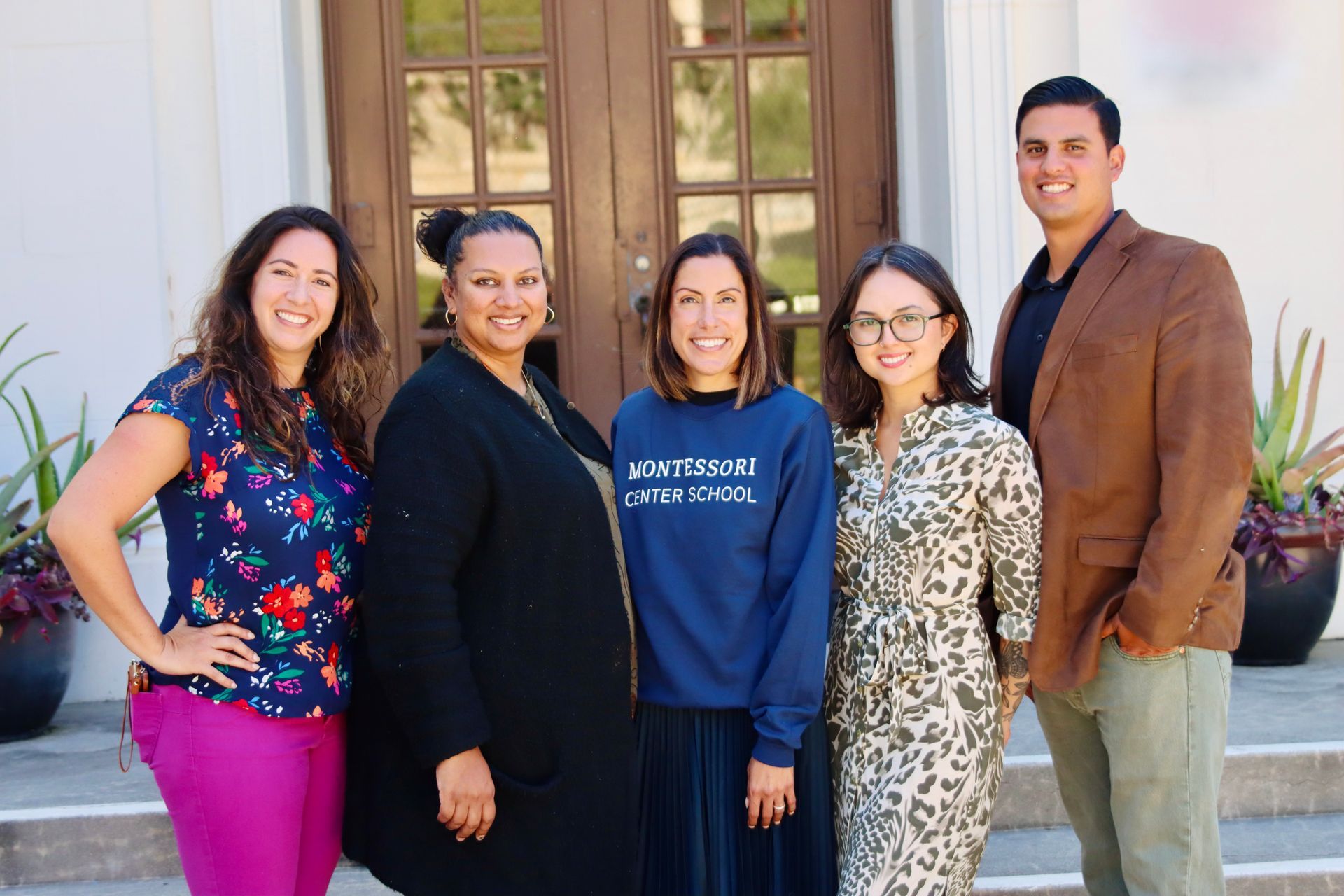
By Lisa Lavora - De Beule
•
19 Oct, 2023
Santa Barbara’s local independent schools Montessori Center School, Crane, Laguna Blanca, Riviera Ridge, and Santa Barbara Middle School hosted an anti-bias, antiracist parent webinar for their community members on October 18 with nationally-recognized antiracist educator, teacher, speaker, and advocate Britt Hawthorne. This marks the first collaboration among the five schools, jointly hosting a community discussion focused on social justice. The event topic, “How to Raise AntiRacist Children,” incorporates tools and tips from Hawthorne’s 2022 New York Times Bestseller, “Raising AntiRacist Children: A Practical Parenting Guide.” “At Montessori Center School , we are committed to engendering a just and equitable school community,” says MCS’s Interim Head of School Vanessa Jackson. “Thank you to our incredible partners at Crane, Laguna Blanca, Riviera Ridge and SBMS for collaborating with us on this important topic. This event presented a very powerful opportunity for us to continue our work to disrupt and dismantle our own biases so that our children can grow up in an environment where all human differences are celebrated and supported.” "At Laguna Blanca , we believe diversity, equity and inclusion is an ongoing practice that demands engagement and lifelong learning. This work is rooted in our core values of scholarship, character, balance, and community. We view this as imperative to creating a better future and invite all members of our community to participate in our conversations and solutions.” - Director of DEI Ursula Chan " Crane School is committed to creating and sustaining a community rooted in equity and justice. Through our programming, curriculum, and events like this, Crane and our partner schools affirm our commitment to building an anti-racist future and a community of critical thinkers capable of reimagining and building a truly beloved community. As our core value Put We Before Me expresses, we believe deeply in the power of collaboration and partnership to overcome division and the -isms that present themselves and to create a strong sense of belonging." - Michelle Holmes, Crane's Director of Diversity, Equity, Inclusion, and Belonging “At Santa Barbara Middle School, we are committed to fostering an environment that actively promotes inclusivity of all students, their families, and their identities. We are honored and proud to be partnering with our fellow independent schools of Santa Barbara to continue this path forward, together. We look forward to more of these collaborations in the future.” - Bianca Vega, SBMS Assistant Head of School “The Riviera Ridge School is committed to creating a campus environment that mirrors the cultural, ethnic, and socio-economic composition of our greater community. With diversity comes a responsibility to honor, value, and celebrate individual differences while providing a safe space of inclusion, belonging, and positive interactions among all School community members. We are grateful for being part of this collaboration and we acknowledge the continuous commitment that is needed to have meaningful progress.” - Dr. Mario Bucio, Director of Student Wellness & EIB practices. About Britt Hawthorne Britt Hawthorne (they/she) is the author of the highly-anticipated, New York Times Bestseller, Raising Antiracist Children: A Practical Parenting Guide (Simon Element, 2022). Britt is also an antiracist educator, teacher, speaker, visionary, and advocate committed to raising a generation of antiracist children by centering families of the global majority and fostering equitable learning environments for students and children of all ages and backgrounds. Her work has been recognized by PBS, the National Education Association, Drew Barrymore, Google for Education, the National Museum of African American History and Culture, Rice University, the Association Montessori Internationale, and countless more. Britt has traveled extensively to speak at conferences, authored publications, and appeared on podcasts covering social justice, liberation, and equity in education.
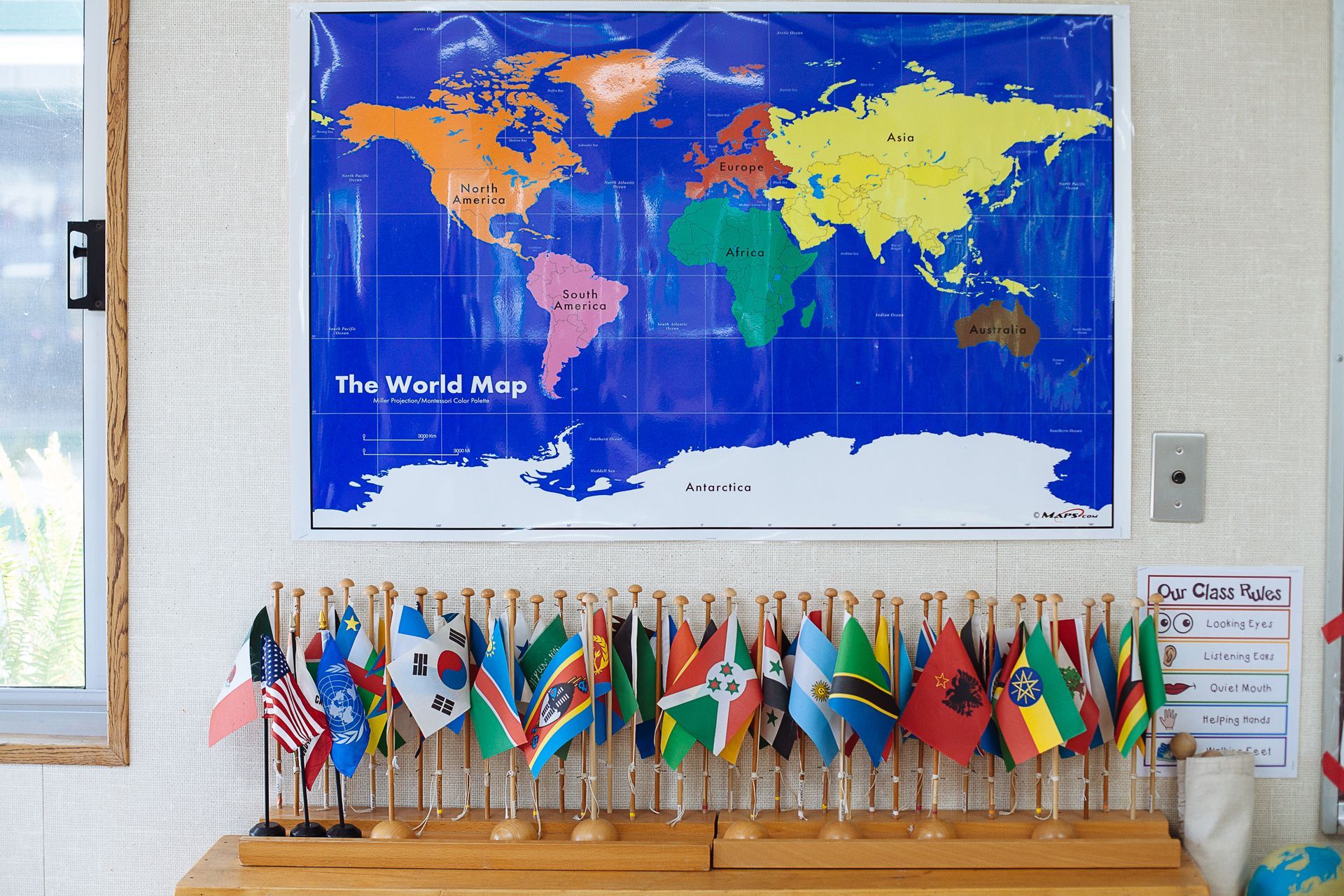
By Lisa Lavora - De Beule
•
10 Oct, 2023
Our world is often a tumultuous and scary place. How can we help our children feel safe and cared for, while preparing them to lead the way as adults? How can we cultivate empathy, kindness, gratitude, and the sense of community that helps people work together? Montessori education has been addressing these issues for over a hundred years. Sometimes the lessons are direct; at other times they are subtler. The mission is always clear: we want children to have a wide view of the world. We want them to appreciate the diversity of others. We want them to have the tools to navigate this world peacefully. How do we approach this critical task? Montessori schools teach peace both directly and indirectly. Sure, we talk about peace and its importance openly and frequently. We talk about what it means and what it looks like and what children can do to become peacekeepers. But, perhaps more importantly, we model. Through our words, the tone of our voices, and with our actions, we show children what it means to be peaceful. They watch our everyday actions and learn so much from them, so why not create constant learning opportunities? Teaching a Global Perspective Even from a very young age, Montessori children are taught geography through the lense of the whole world. They learn about the continents when they are as young as three years old. These studies often include learning about biomes, instead of an emphasis on political boundaries. Teaching about the world in this way gives children a sense of the natural world and people as a whole as primary to different countries. Elementary aged Montessori children enjoy many lessons with timelines. They learn about the origins of humanity, and studying ancient cultures is fascinating for them. Embracing a Variety of Cultures One important series of lessons in the elementary years teaches the fundamental needs of humans. Children explore how groups of people around the world and across the ages meet and have met their needs. Physical needs, such as food, shelter, defense, and transportation are considered, as well as spiritual needs like art and religion. Giving Them Tools Montessori teachers are equipped to give children skills to resolve conflicts. We give children tools such as micro-mediation, and give them the words and actions to express their needs and feelings while listening to those of others. In Montessori classrooms, children often learn a variety of self-calming strategies. This might include mindfulness meditation, yoga, breathing exercises, or the use of small hand-held tools such as a finger labyrinth or polished stone. Taking the Time In Montessori classrooms the day is not structured with rigid timed intervals. For example, there is no predetermined time for math, reading, etc. This flexible schedule lends itself to shifting courses and having discussions in the moment. For example, if a group of children are experiencing difficulty resolving a problem together, the teacher is able to stop and sit with them. Without feeling rushed, they can take the time to figure out what went wrong and how to make it right. Instead of an adult doling out consequences, we have the time to sit and work through conflict authentically. Giving to the Community As Montessori children get older, they are encouraged to give back to their community. These acts of charity will often be inspired by the children’s ideas. Children may collect food and supplies for a local animal shelter, read stories and sing songs to residents of a nursing home, or make and sell baked goods to benefit a cause they believe in. By supporting children with logistics, we can encourage them to learn how to be active and supportive members of their communities at a young age. They learn the importance of volunteering and contribution to others. Giving back is just one way a child begins their active role as a peaceful member.
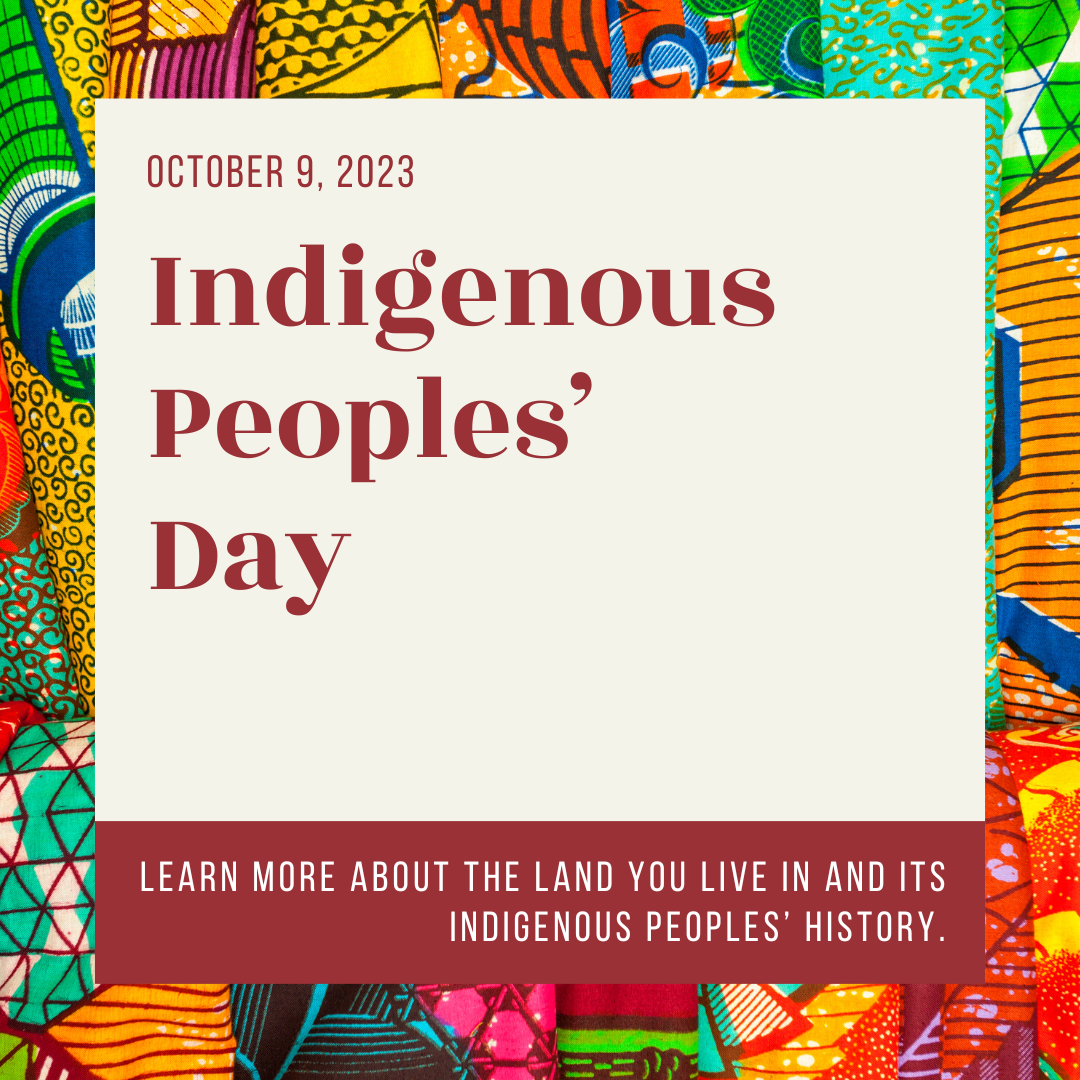
By Lisa Lavora - De Beule
•
04 Oct, 2023
On this day we recognize and honor the Indigenous Peoples who are the original stewards of the lands on which we now live. Acknowledging the land we occupy is by itself a small gesture. Yet this first step of showing respect and support can become more meaningful when coupled with informed action, authentic relationships, and work toward reconciliation. To help ourselves and our children become more aware, informed, and accountable, we can start by sharing stories about the present-day life and culture of Native Peoples, celebrating indigenous activism, and learning about the history of the people whose land we live on. All too often our children have unconsciously absorbed harmful stereotypes about Indigenous Peoples or that Native Americans only existed in our country’s past. Thus, we need to be very intentional about providing current, accurate, and respectful information on Indigenous Peoples’ Day and throughout the year. Show Representation Mainstream culture often presents native peoples as fierce, war-like, and to be feared, or sometimes in a more romanticized, puristic way. Children absorb these kinds of stereotypes through sports mascots, books, movies, and even place names. Non-native authors sometimes also unintentionally reinforce stereotypes or conflate different tribes’ cultures and histories. Countering these messages takes conscious work. An easy way to begin is by sharing books that show native people living in our current time period. Young children cannot distinguish between the past and the present and showing Native Peoples in current day settings disrupts the false narrative that Native Americans are a “people of the past.” One of the best sources we’ve found is Rebekah Gienapp’s list of indigenous children’s books. In addition to reading stories and sharing books with more accurate representation, we can also incorporate books, art, and music created by American Indians. If you’d like some sources to help begin this journey, check out: Children: Read Christopher the Ogre Cologre, It's Over! Everyone: Support Birchbark Books , an independent bookstore that supports Indigenous arts. As you browse, consider choosing Shapes of Native Nonfiction: Collected Essays by Contemporary Writers , An Indigenous Peoples' History of the United States , and books from this list of “40 Best Native American Authors to Read in 2023." Native American Musicians We Should Know Embracing Contemporary Native American Art as Contemporary Art Why Study Native American Literature Project 562: A multi-year national photography project dedicated to photographing over 562 federally recognized Tribes, urban Native communities, Tribes fighting for federal recognition, and Indigenous role models Meet Indigenous Speakers and Learn How They’re Keeping Their Languages Alive Through their own words, music, performance, and advocacy, Native American and Indigenous artists share important insights into their hopes, fears, traditions, and stories. In the process of taking in more respectful representation, our young people can offer more acceptance and experience more genuine appreciation. Focus on Your Community We can also accompany our children on a journey of learning about the original people who lived on the land we now occupy. This investigation is most suitable for children as they enter their elementary years, as it means digging into some history. In this process, we can help our children appreciate how there are multitudes of Native American nations and that each has their own language, culture, history, and traditions. As we learn about the Native Peoples of our place, we can then be more specific as we talk about native culture. For example, “This book is about the Mohican people.” An amazing interactive resource that can help children also appreciate geography through a cultural lens is the Native Land Digital map: https://native-land.ca/ . Because the map does not show political boundaries, children can visually discover some of the fluidity of native territories and languages. The site also provides links to local Native American nations for more information. A few Santa Barbara area resources: here , here and here . Celebrate Activism As we learn more about and honor our Native Peoples, it’s important that we and our children are also aware of indigenous struggles and victories. We can start by introducing one of the many movements for native rights . We can also find local events that feature Native Peoples and then ideally support those events that give back to the Indigenous community. Britt Hawthorne shares helpful information for parents and educators to learn how to do a land acknowledgement with your kids and in the classroom. As we learn with our children, we can also explore ideas for making reparations. The Land You Live On: An Education Guide by Native Land recommends first honoring a nation by taking the time to learn how to pronounce a nation’s name correctly. Three options listed in The Land You Live On are: Respectfully ask someone from the nation. Check the nation’s website for a phonetic pronunciation on their “About” page, an audio recording of their name, or videos that include people saying the nation’s name. Call the nation after hours and listen to their voicemail recording. The Native Land Education Guide also encourages thoughtful reflection in order to make Land Acknowledgements more meaningful. Helpful questions provided include: Why is this acknowledgment happening? How does this acknowledgment relate to the event or work you are doing? What is the history of this territory? What are the impacts of colonialism here? What is your relationship to this territory? How did you come to be here? What intentions do you have to disrupt and dismantle colonialism beyond this territory acknowledgment? On this Indigenous Peoples’ Day, let’s commit to having a greater consciousness and disrupting false narratives throughout the year. In this process, we can help our young people feel more empowered to provide support and take action. #EducateEngageEmpower #LearnerEmpowerement #RespectForAll
Programs
Montessori Center School admits students of any race, color, religion, national and ethnic origin, gender identity, and sexual orientation to all rights, privileges, programs and activities general recorded or made available to students at the School. It does not discriminate on the basis of race, color, religion, national and ethnic origin, gender identity or sexual orientation in the administration of its educational programs, admission and tuition assistance policies, and athletic or other school-administered programs. Non-Profit Education Organization, License No. 426205239

